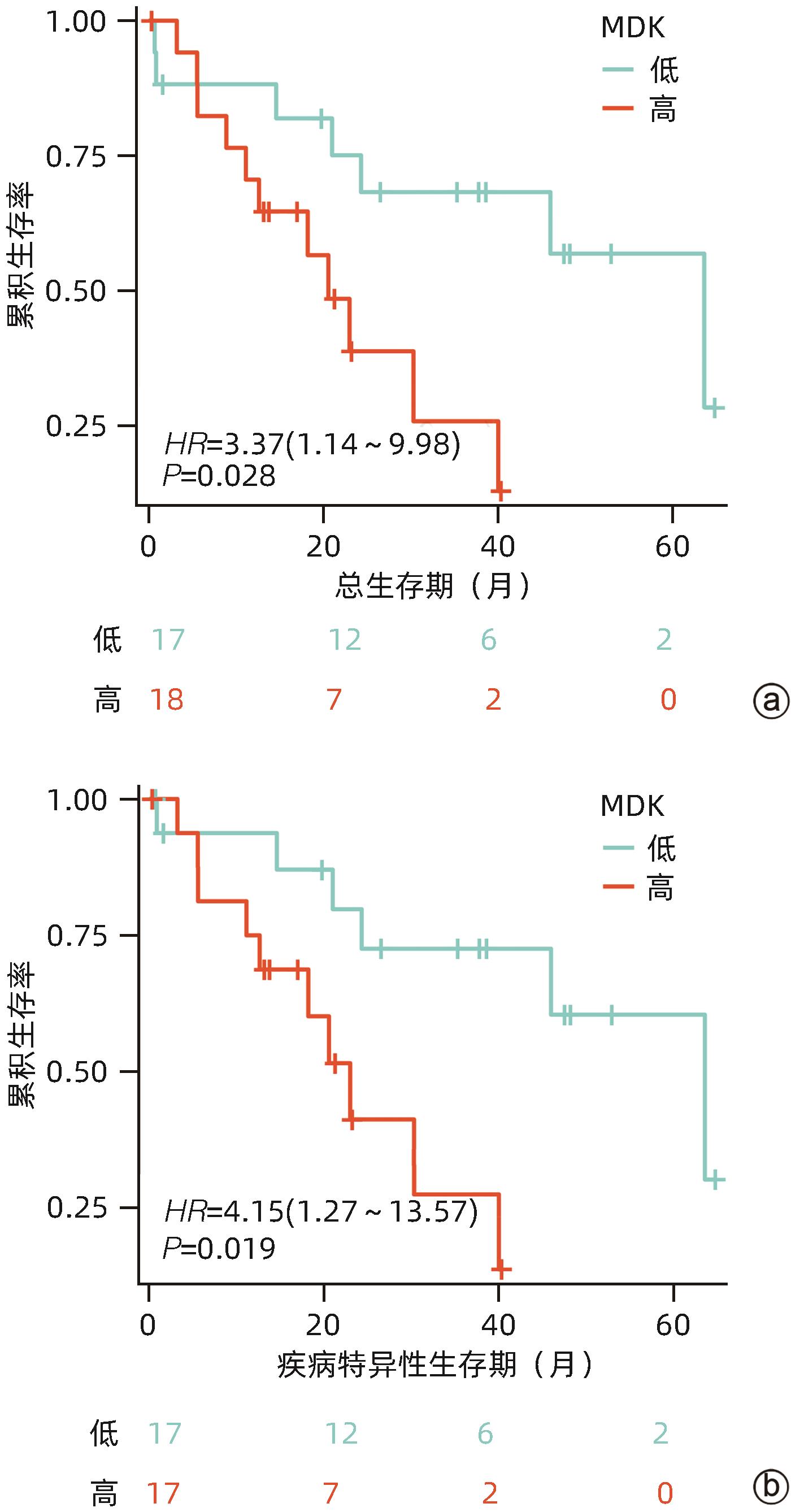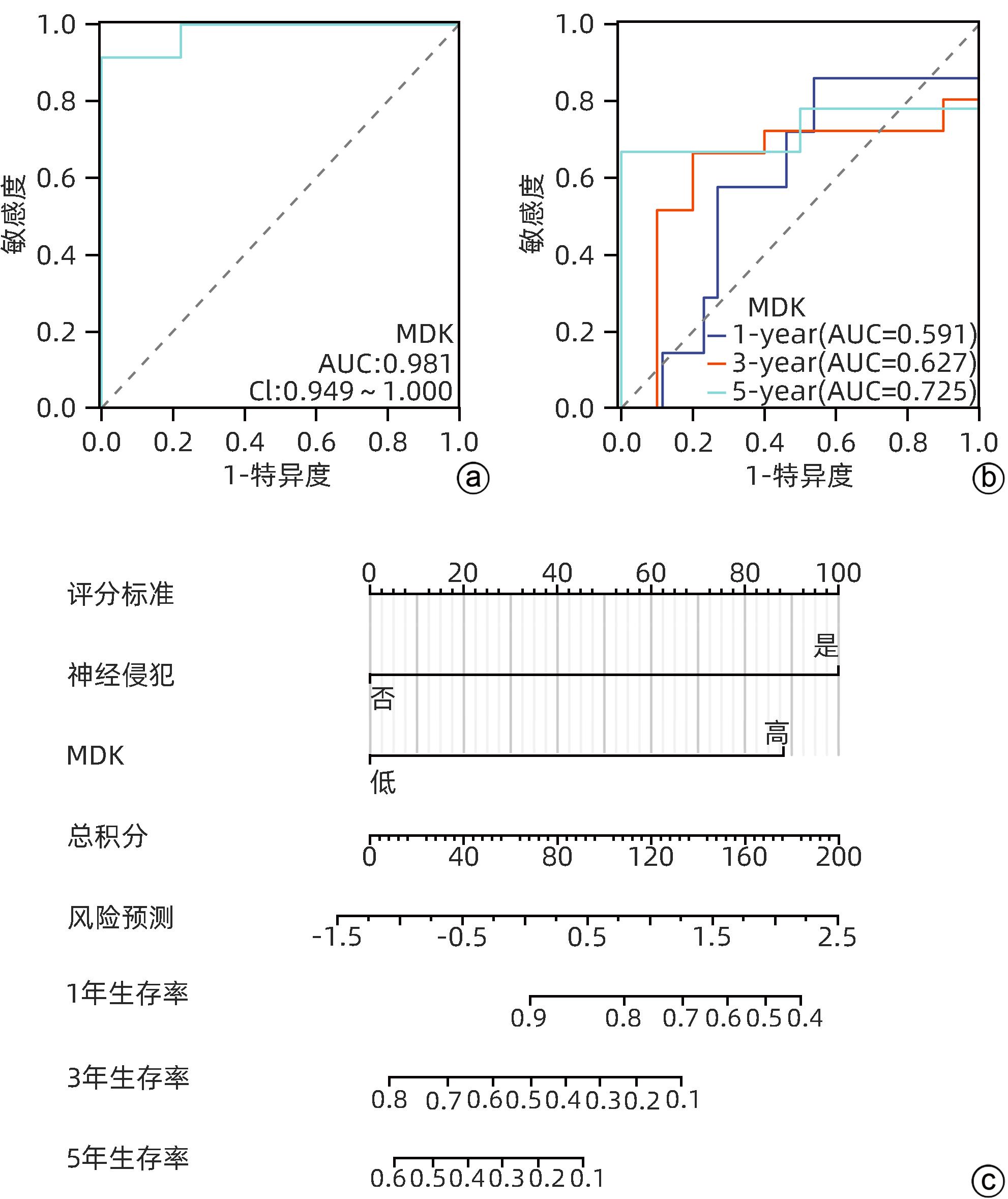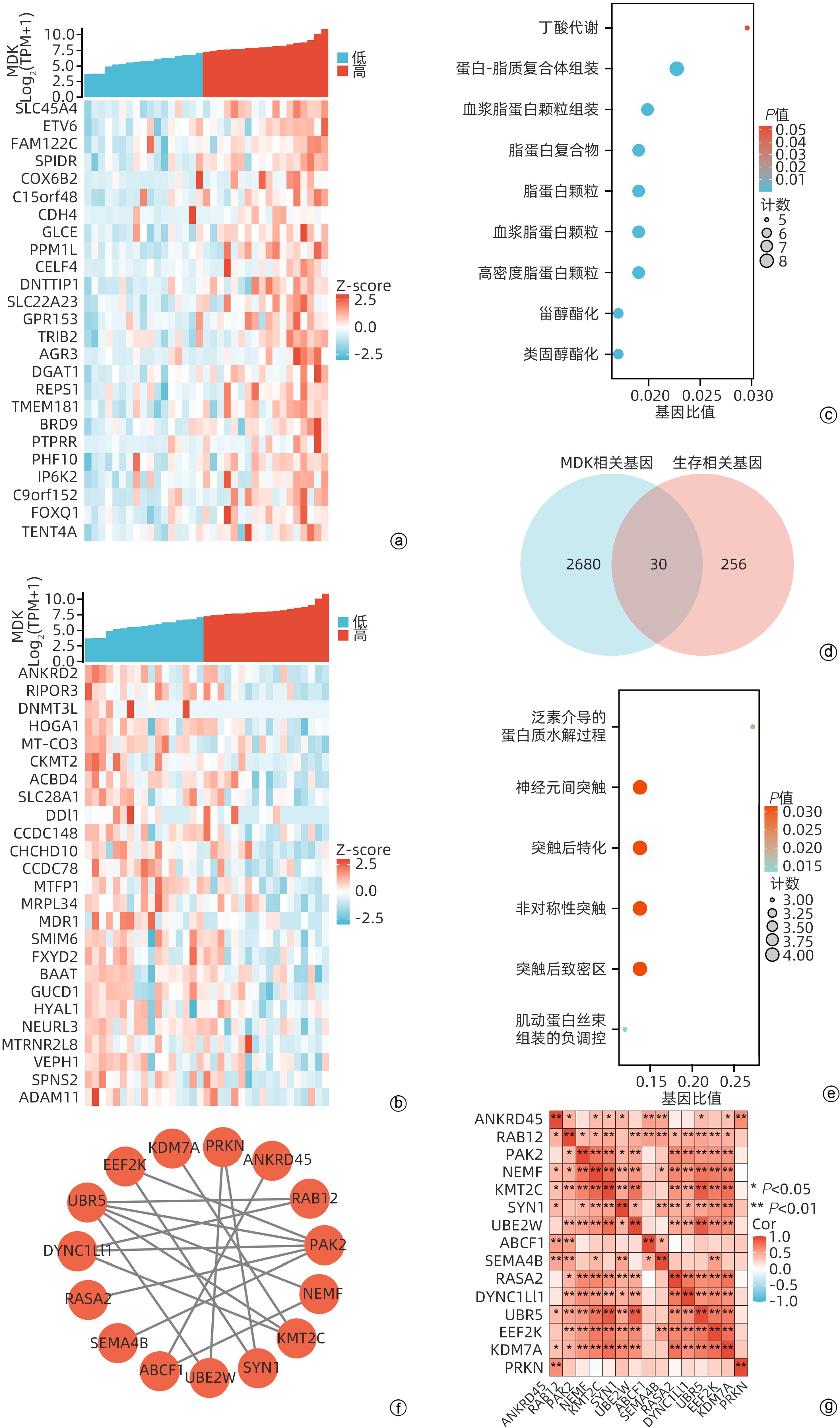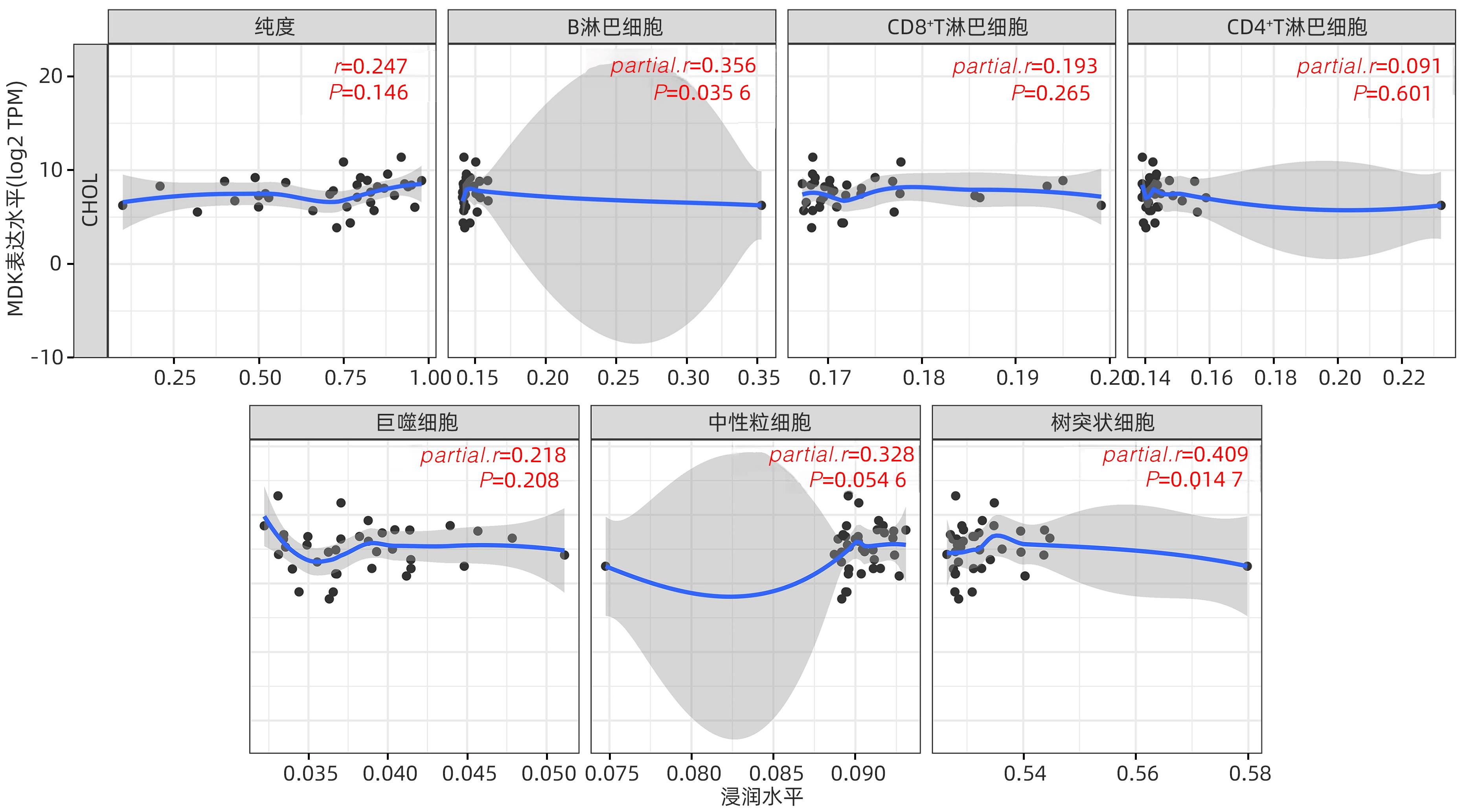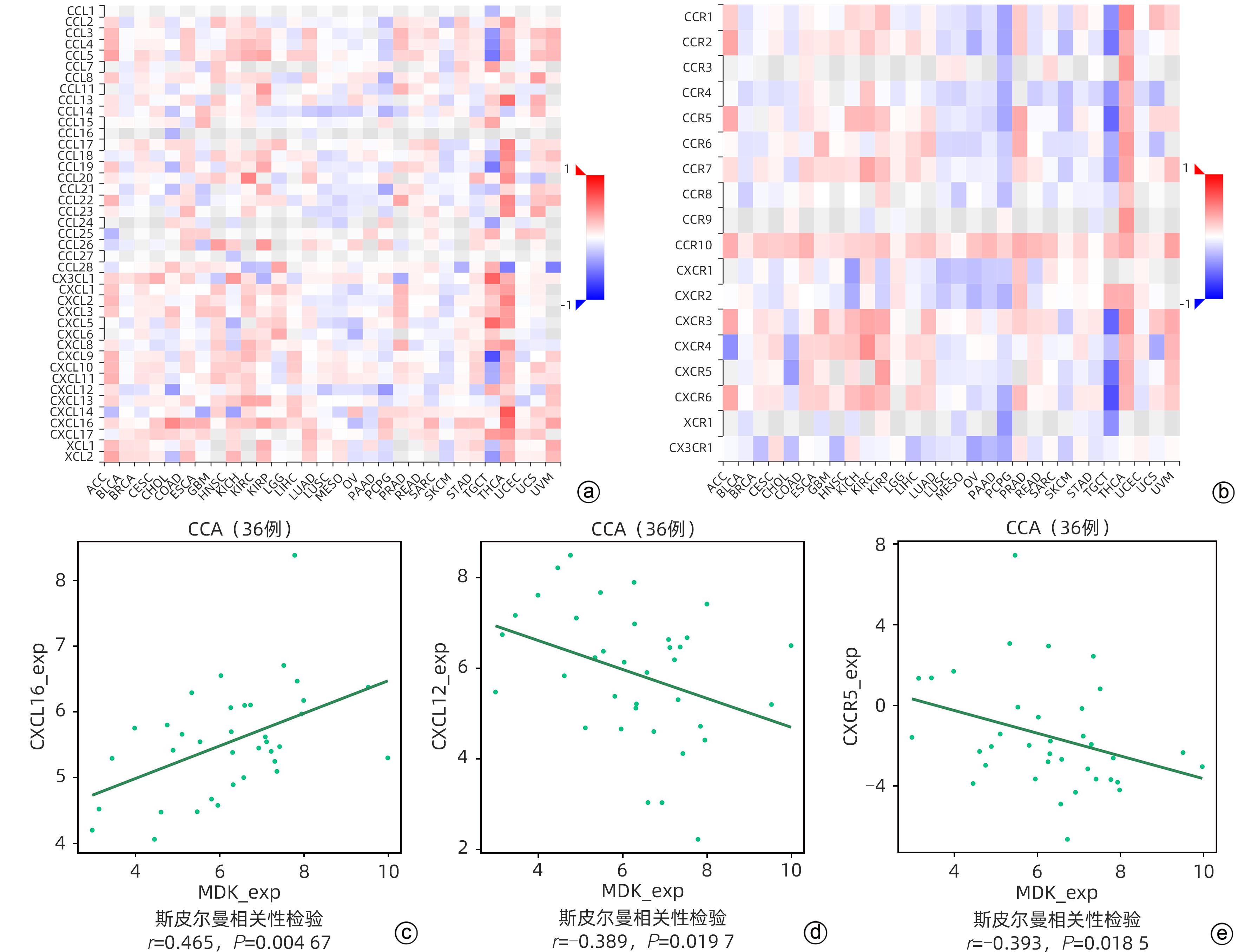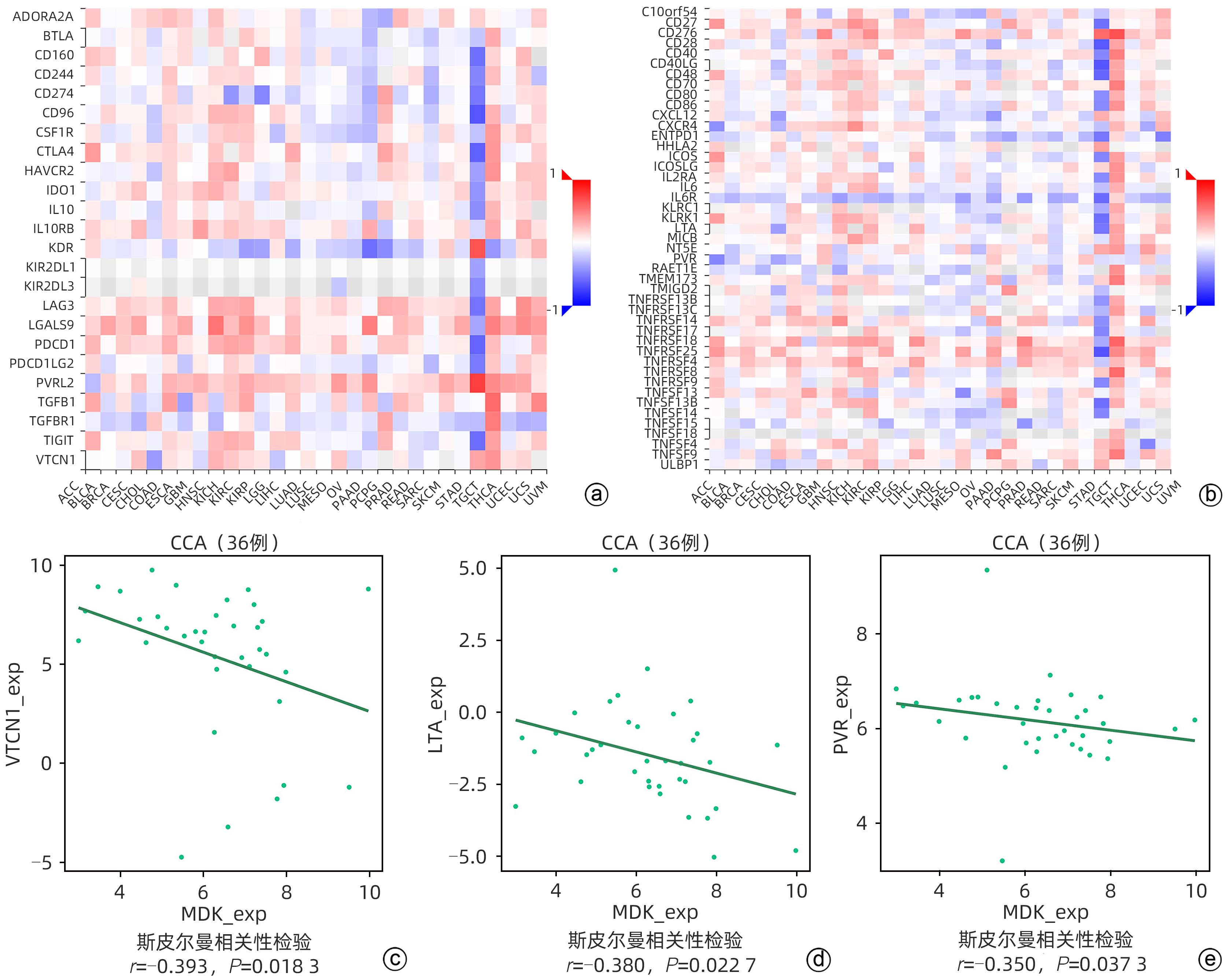基于生物信息学分析Midkine在胆管癌中的表达及其对预后的预测价值
DOI: 10.12449/JCH240722
Expression of Midkine in cholangiocarcinoma and its value in predicting prognosis based on bioinformatics analysis
-
摘要:
目的 研究中期因子(MDK)在胆管癌(CCA)中的表达及其对患者预后的预测价值,探索MDK可能影响CCA进展的机制。 方法 从癌症基因组图谱(TCGA)数据库获取CCA样本数据信息,分析MDK在癌与癌旁组织中的表达差异及其与临床特征的相关性,使用基因表达综合数据库(GEO)和解放军总医院第五医学中心2018年6月—2021年9月经手术切除的11例CCA患者的临床资料进行相关验证。通过STRING和Cytoscape构建蛋白互作网络,使用基因本体(GO)和京都基因与基因组数据库(KEGG)进行富集分析,探讨MDK相关基因所参与的生物学过程和肿瘤相关通路。此外,应用TIMER和TISIDB数据库分析CCA肿瘤组织中MDK的表达与免疫细胞浸润的相关性。计量资料两组间比较采用成组t检验或Mann-Whitney U检验。计数资料组间比较采用Fisher精确概率法。应用Kaplan-Meier法绘制生存曲线,并采用Log-rank检验进行组间比较。两变量间的相关性采用Spearman相关性分析。 结果 比较TCGA数据库中CCA患者肿瘤组织及癌旁组织中MDK的表达水平,非配对分析结果和配对分析结果均显示,MDK在CCA肿瘤组织中的表达水平高于癌旁组织(P值均<0.001);对纳入的11例CCA患者肿瘤组织及其配对癌旁组织标本进行转录组测序,结果显示,MDK在CCA肿瘤组织中的表达水平显著高于其配对癌旁组织(P<0.01)。MDK高表达与淋巴结转移(P=0.045)和血管侵犯(P=0.044)有关。生存分析显示,MDK高表达的CCA患者总生存期(χ2=5.30,P=0.028)及疾病特异性生存期(χ2=6.25,P=0.019)均明显短于MDK低表达的患者。GO和KEGG富集分析显示,MDK表达相关的30个基因与泛素介导的蛋白质水解过程密切相关,并影响CCA患者预后;TIMER分析结果显示,MDK表达与B淋巴细胞(r=0.356,P=0.035 6)和树突状细胞(r=0.409,P=0.014 7)在肿瘤组织微环境中的浸润呈正相关;TISIDB分析结果显示,MDK表达水平与CXCL16(r=0.465,P=0.004 67)呈正相关,与CXCL12(r=-0.389,P=0.019 7)及CXCR5(r=-0.393,P=0.018 5)呈负相关;与免疫检查点调节剂VTCN1(r=-0.393,P=0.018 3)、LTA(r=-0.380,P=0.022 7)和PVR(r=-0.350,P=0.037 3)呈负相关。 结论 MDK高表达提示CCA患者预后不佳,MDK有潜力成为预测CCA患者预后的分子标志物,其可能通过调控泛素介导的蛋白质水解过程及调控B淋巴细胞和树突状细胞的浸润促进CCA的发生发展。 Abstract:Objective To investigate the expression of Midkine (MDK) in cholangiocarcinoma (CCA) and its value in predicting the prognosis of CCA, as well as the potential mechanism of the effect of MDK on the progression of CCA. Methods The data of CCA samples were obtained from TCGA database to analyze the difference in the expression of MDK between cancer tissue and paracancerous tissue and its association with clinical features, and the data collected from GEO database and 11 CCA patients who underwent surgical resection in The Fifth Medical Center of Chinese PLA General Hospital from June 2018 to September 2021 were used for validation. STRING and Cytoscape were used to construct a protein-protein interaction network, and gene ontology (GO) and Kyoto Encyclopedia of Genes and Genomes (KEGG) enrichment analyses were used to investigate the biological functions and tumor-related pathways involving MDK-related genes. In addition, TIMER and TISIDB databases were used to analyze the correlation between MDK expression and immune cell infiltration in CCA tissue. The independent-samples t test or the Mann-Whitney U test was used for comparison of continuous data between two groups, and the Fisher’s exact test was used for comparison of categorical data between two groups. The Kaplan-Meier method was used to plot survival curves, and the Log-rank test was used for comparison between groups. The Spearman correlation analysis was used to investigate the correlation between two variables. Results The expression level of MDK in cancer tissue and paracancerous tissue of CCA patients was compared based on TCGA database, and the results of the non-paired and paired analyses showed that the expression level of MDK in CCA tumor tissue was significantly higher than that in paracancerous tissue (P<0.001). Transcriptome sequencing was performed for the tumor tissue and its corresponding paracancerous tissue from 11 CCA patients, and the results showed that the expression level of MDK in CCA tumor tissue was significantly higher than that in corresponding paracancerous tissue (P<0.01). High expression of MDK was associated with lymph node metastasis (P=0.045) and vascular invasion (P=0.044). Survival analysis showed that compared with the CCA patients with low MDK expression, the CCA patients with high MDK expression had significantly shorter overall survival time (χ2=5.30, P=0.028) and disease-specific survival time (χ2=6.25, P=0.019). The GO and KEGG enrichment analyses showed that the 30 MDK-related genes were closely associated with ubiquitin-mediated proteolysis and affected the prognosis of CCA patients. The TIMER analysis showed that the expression level of MDK was positively correlated with the infiltration of B cells (r=0.356, P=0.035 6) and dendritic cells (r=0.409, P=0.014 7) in tumor microenvironment of CCA; the TISIDB analysis showed that the expression level of MDK was positively correlated with CXCL16 (r=0.465, P=0.004 67) and was negatively correlated with CXCL12 (r=-0.389, P=0.019 7) and CXCR5 (r=-0.393, P=0.018 5), and it was also negatively correlated with the immune checkpoint regulators VTCN1 (r=-0.393, P=0.018 3), LTA (r=-0.380, P=0.022 7), and PVR (r=-0.350, P=0.037 3). Conclusion High expression of MDK is associated with poor prognosis in CCA patients, and MDK has the potential of being used as a molecular marker for predicting the prognosis of CCA. MDK may promote the development and progression of CCA by regulating ubiquitin-mediated proteolysis and the infiltration of B cells and dendritic cells. -
Key words:
- Cholangiocarcinoma /
- Midkine /
- Prognosis
-
原发性肝癌是目前全球第六大常见癌症,也是导致癌症相关死亡的第三大常见原因[1],其中肝细胞癌(HCC)占75%~85%。由于HCC发病隐匿,进展迅速,高达80%的HCC患者在首次诊断时已处于中晚期,5年生存率不足15%[2]。因此,亟需探明HCC发生发展的分子机制,为HCC早期诊断和精准治疗提供靶点。AU富集元件结合因子1(AU-rich element RNA-binding factor 1,AUF1)是真核细胞中重要的转录后调节因子[3]。AUF1通过与mRNA的AU元件富集区结合,调控多种mRNA的稳定性及翻译,其异常表达与炎症、衰老、发育异常和心血管疾病等密切相关[4-6]。AUF1也是一种潜在的致癌因子,在多种肿瘤的发生发展中发挥重要作用[7-8],但AUF1在肿瘤发生发展中的作用机制尚未完全阐明。本研究利用UALCAN和TCGA-HCC数据库分析AUF1在包括HCC在内的多种肿瘤组织中的表达以及AUF1表达与HCC患者预后的相关性,并分析AUF1对肝癌细胞增殖、凋亡、迁移能力的影响及可能机制,以期为阐明AUF1在HCC进展中发挥的作用及分子机制提供依据。
1. 材料与方法
1.1 主要材料与试剂
siAUF1和对照siNC购自广州锐博生物;pCDH-AUF1及对照质粒(pCDH)为本实验室构建保存;细胞DMEM培养基、胎牛血清和胰蛋白酶购自美国Gibco公司;转染试剂Lipo fectamineTM RNAiMAX Transfection Reagent、Lipo fectamineTM 2000试剂购自美国Invitrogen公司;鼠抗E-cadherin购自美国BD transduction laboratories公司;鼠抗N-cadherin购自美国Santa Cruz公司;兔抗AUF1抗体和兔抗β-cateinin购自英国Abcam公司;鼠抗人β-tubulin抗体和蛋白定量试剂购自北京普利莱公司;兔抗β-actin购自美国CST公司;CCK-8试剂盒、Annexin V-FITC试剂盒购自日本Dojindo公司。
1.2 肝癌细胞系
HepG2细胞购自美国ATCC细胞库,Huh7和Huh1细胞购自中国科学院上海细胞库。使用含有10%胎牛血清、100 U/mL青霉素、链霉素的DMEM培养基于37 ℃,5% CO2的培养箱中培养,待细胞融合度达约80%时,用0.25%胰蛋白酶进行消化传代,取生长至对数期的细胞用于实验研究。
1.3 生物信息学分析
采用UALCAN数据库分析AUF1在泛癌中的表达[9-10];采用TCGA-HCC数据库分析AUF1表达与HCC患者临床病理特征及预后的相关性。
1.4 细胞转染实验
转染前24 h进行细胞传代并计数,按照3.5×105个/孔将细胞接种于6孔板中。按照Lipo fectamineTM RNAiMAX Transfection Reagent的说明书,将siAUF1或对照siNC转染至HepG2、Huh7或Huh1细胞中。pCDH-AUF1和对照质粒按照Lipo fectamineTM 2000说明书进行转染。转染4~6 h后,更换为新鲜的DMEM完全培养基继续培养,并于转染48 h后收集细胞,用于后续实验研究。
1.5 Western Blot检测
收集细胞沉淀,加入RIPA裂解液进行细胞裂解,使用BCA法测定蛋白浓度。SDS-PAGE电泳分离蛋白,转移至PVDF膜,5%脱脂牛奶室温封闭,4 ℃孵育一抗过夜。室温孵育二抗1 h。用美国LI-COR公司Odyssey双色红外激光成像系统采集图像,使用β-tubulin或β-actin作为内参。
1.6 CCK-8实验
在96孔板上以8×103细胞/孔的密度接种细胞。每组设置6个复孔。分别在接种后的0、1、2、3、4、5天在每孔加入含有10 μL CCK-8的100 μL培养基,37 ℃孵育1 h。在450 nm波长下测量吸光度,根据吸光度绘制生长曲线。
1.7 Transwell迁移实验
取得转染24 h后的细胞悬液,PBS清洗去除血清,再用无血清DMEM培养基重悬细胞,将其均匀加入小室中(5×103/200 μL)。在24孔板中加入600 μL含10% FBS的DMEM培养基,镊子夹取小室平稳放入其中,培养36 h。PBS清洗小室及24孔板,经固定、染色后,去除小室中残留的水分及未穿过小室聚碳酸酯膜的细胞。风干,显微镜下拍照。
1.8 细胞凋亡实验
将4×105个细胞/孔置于6孔板中培养48 h,消化离心后弃上清,使用PBS冲洗细胞沉淀2遍,加入300 μL结合缓冲液重悬细胞。加入5 μL Annexin V-FITC和5 μL PI,室温避光孵育15 min,并使用流式细胞仪检测。
1.9 RNA测序(RNA-seq)数据分析
本文数据下载自GEO数据库GSE162706数据集[11]。Hisat2[12]和featureCounts[13]用于读图和基因计数计算。edgeR软件[14]用于基因差异表达分析。
1.10 统计学方法
采用FPKM(fragmenls per kilobasemillion)法对TCCA转录组测序数据进行标准化,最终纳入预后分析的HCC样本来自于370例不同病因的HCC患者。使用R语言进行统计学分析及绘图。计量资料两组间比较采用t检验。采用Kaplan-Meier绘图仪数据库(http://www.kmplot.com)评估肝癌患者AUF1表达与无复发生存率之间的关系,并使用Log-rank检验进行生存率比较。P<0.05为差异有统计学意义。
2. 结果
2.1 AUF1在多种肿瘤组织中异常表达
利用UALCAN数据库分析AUF1在24种肿瘤和相对应正常组织中的mRNA表达情况(图1a)。与正常组织相比,AUF1 mRNA水平在膀胱尿路上皮癌(BLCA)、乳腺癌(BRCA)、胆管癌(CHOL)、结肠癌(COAD)、食管癌(ESCA)、多形性胶质母细胞细胞瘤(GBM)、头颈鳞状细胞癌(HNSC)、肾透明细胞癌(KIRC)、HCC、肺腺癌(LUAD)、肺鳞癌(LUSC)、前列腺癌(PRAD)、胃癌(STAD)中高表达(P值均<0.05),但在肾嫌色细胞癌(KICH)和甲状腺癌(THCA)中则呈低表达(P值均<0.05)。除此之外,本研究利用UALCAN数据库分析AUF1蛋白在10种肿瘤组织中的表达情况。结果显示,AUF1蛋白在9种肿瘤组织中表达升高(图1b),包括BRCA、COAD、卵巢癌(OV)、肾透明细胞癌(ccRCC)、子宫内膜样癌(UCEC)、肺癌(LUNG)、HNSC、GBM、HCC(P值均<0.05),而在胰腺癌(PAAD)中AUF1蛋白水平降低(P值均<0.05)。综上结果显示,AUF1的mRNA和蛋白水平在HCC、BRCA、COAD、GBM、HNSC中均显著上调,提示AUF1可能在包括HCC在内的多种肿瘤中发挥促癌作用。
2.2 AUF1高表达与HCC患者的不良预后相关
为进一步探究AUF1与肝癌的关系,本研究分析TCGA-HCC数据库中AUF1表达水平与HCC患者临床病理特征的关系。结果显示,AUF1与肿瘤恶性标志物MKI67的表达水平呈正相关(r=0.552 2,P<0.000 1)(图2a)。在不同肝癌Edmondson-Steiner分级中,AUF1 mRNA水平在3级肿瘤中的表达高于1级和2级(P值均<0.000 1)(图2b)。在临床不同TNM分期患者中,AUF1在TNM-Ⅲ期肿瘤组织中的表达水平高于TNM-Ⅰ(P<0.000 1)(图2c)。但无论是Edmondson-Steiner分级还是TNM分期中,4级或TNM-Ⅳ期肝癌组织中AUF1的表达均未见升高。本研究进一步根据TNM分期分别对AUF1表达水平在HCC中的预后能力进行评估。Kaplan-Meier生存分析显示,在早期(Ⅰ~Ⅱ期)肝癌中,AUF1高表达患者的半数生存期仅为30.1个月,显著低于AUF1低表达患者的半数生存期55.87个月(P=0.048)(图2d)。AUF1表达水平与中晚期肝癌(Ⅲ~Ⅳ期)的半数生存期无相关性(P>0.05)。上述结果提示,AUF1的异常表达可能参与HCC的发生和发展,是早期肝癌诊断和预后的潜在标志物。
2.3 AUF1促进肝癌细胞增殖
为探究AUF1对肝癌细胞增殖能力的影响,本研究在肝癌细胞系中分别敲减或过表达AUF1,并通过CCK-8实验检测细胞的增殖能力。结果显示,与siNC对照组相比,转染AUF1 siRNA后,HepG2和Huh1细胞中AUF1蛋白水平明显降低(图3a),且敲减AUF1后HepG2和Huh1细胞增殖能力明显低于对照组(图3b)。与敲减结果一致,过表达AUF1的HepG2和Huh7(图3c)细胞增殖能力明显高于pCDH对照组(图3d)。
2.4 AUF1抑制肝癌细胞的凋亡
本研究进一步使用Annexin V/PI双染色法评价AUF1对肝癌细胞凋亡的影响。结果显示,与对照siNC组相比,敲减AUF1后HepG2细胞和Huh1细胞中Annexin V单阳性和Annexin V/PI双阳性细胞比例明显上调,表明细胞的早期和晚期凋亡率增加(图4a)。而在过表达AUF1的HepG2和Huh7细胞中,细胞的早期和晚期凋亡率较pCDH对照组则显著降低(图4b)。
2.5 AUF1抑制肝癌细胞的迁移能力
本研究随后检测AUF1对肝癌细胞迁移能力的影响。Transwell迁移实验结果显示,与对照siNC组相比,AUF1敲减可增强HepG2和Huh1细胞的迁移能力(图5a)。Western Blot检测结果显示,AUF1敲减后E-cadherin水平降低、N-cadherin水平升高(图5b)。与此结果一致,过表达AUF1后Huh7细胞的迁移能力较对照质粒pCDH组降低(图5c),细胞内的E-cadherin蛋白水平升高、N-cadherin蛋白水平降低(图5d)。
 注: a,Transwell实验检测AUF1敲减对细胞迁移能力的影响(结晶紫染色,×20);b,Western Blot检测AUF1敲减对E-cadherin和N-cadherin水平的影响;c,Transwell实验检测AUF1过表达对细胞迁移能力的影响(结晶紫染色,×20);d,Western Blot检测AUF1过表达对E-cadherin和N-cadherin水平的影响。图 5 AUF1对肝癌细胞迁移能力的影响Figure 5. The effect of AUF1 on the migration ability of hepatocellular carcinoma cells
注: a,Transwell实验检测AUF1敲减对细胞迁移能力的影响(结晶紫染色,×20);b,Western Blot检测AUF1敲减对E-cadherin和N-cadherin水平的影响;c,Transwell实验检测AUF1过表达对细胞迁移能力的影响(结晶紫染色,×20);d,Western Blot检测AUF1过表达对E-cadherin和N-cadherin水平的影响。图 5 AUF1对肝癌细胞迁移能力的影响Figure 5. The effect of AUF1 on the migration ability of hepatocellular carcinoma cells2.6 AUF1通过激活Wnt信号通路发挥促癌作用
为探究AUF1促癌的潜在机制,本研究通过转录组测序(RNA-seq)分析AUF1敲减对HepG2细胞转录组的影响。利用cuffdiff分析模块进行基因差异表达分析,并根据差异倍数和P值进行筛选,共获得467个差异基因。其中162个基因在AUF1敲减后表达上调,305个基因表达显著下调(图6a)。进一步对这些AUF1相关差异基因进行KEGG pathway分析,如结果所示,主要富集在Wnt信号通路、细胞黏附因子、5-羟色氨酸突触、花生四烯酸代谢等多种通路上,其中Wnt信号通路富集到的差异基因数排在前列(图6b)。
β-catenin蛋白上调是Wnt通路活化的重要标志。本研究进一步通过Western Blot实验检测肝癌细胞内β-catenin蛋白水平。结果显示,敲减AUF1后HepG2中的β-catenin蛋白下调。而过表达AUF1后β-catenin蛋白上调(图6c)。上述结果提示AUF1可以通过上调β-catenin激活肝癌细胞中的Wnt信号通路。
3. 讨论
AUF1的异常表达与多种肿瘤的发生发展相关,但多数相关研究均基于RNA水平检测,缺少AUF1蛋白水平检测。本研究利用UALCAN数据库,系统分析了泛癌转录组学和蛋白质组学数据中AUF1 mRNA和蛋白在多种肿瘤中的表达情况。本研究发现,与AUF1 mRNA水平一致,AUF1蛋白水平在多种肿瘤组织中亦呈高表达,提示其在这些肿瘤中发挥促癌作用。但在PAAD中,AUF1的mRNA或蛋白水平均降低,提示AUF1的异常表达与不同肿瘤类型有关。
前期通过检测配对的HBV肝癌组织与癌旁组织发现,AUF1在肝癌组织中高表达,并与患者的预后不良有关[15]。本研究利用TCGA-HCC数据库,进一步证实AUF1在肝癌组织中高表达,且其表达水平与MKI67、Edmondson-Steiner分级、TNM分期等多项肿瘤恶性病理学指标正相关。更为重要的是,本研究发现AUF1表达水平随着肝癌分期逐步上调,但在晚期(Ⅳ期)不再继续升高。生存分析结果也显示AUF1对肝癌早期(Ⅰ~Ⅱ期)更有预后价值。体外实验证实AUF1能促进肝癌细胞增殖、抑制肝癌细胞凋亡和迁移。有报道[16]AKR1B10、c-Myc等癌基因在肝癌早期发挥促癌作用,且具有抑制细胞迁移的能力。因此,笔者推测AUF1异常表达可能与肝癌的早期进展有关,是肝癌早期诊断和预后的一个重要指标。
Wnt/β-catenin通路是一种高度保守且严格控制的信号通路,可调节胚胎发育、细胞增殖和分化。越来越多证据表明Wnt信号通路的异常激活促进肝癌增殖[17]。据报道[18],在约49%的HCC病例中可检测到β-catenin的活化。β-catenin已经被公认为原发性肝癌中最常见的突变基因之一。本研究在HepG2细胞系中敲减AUF1后进行转录组测序,将差异基因进行富集分析,发现差异基因功能富集最显著的是Wnt信号通路,并进一步通过细胞实验证明AUF1激活Wnt通路。本研究发现AUF1敲减后差异基因富集在Wnt通路,Western Blot检测也证实AUF1能够上调β-catenin蛋白水平,提示AUF1通过激活Wnt/β-catenin通路发挥促癌作用。但AUF1激活Wnt通路的具体机制目前尚未明确。笔者团队前期研究发现,AUF1也可以转录后调控AKR1B10、AFP表达。有文献[19]报道AKR1B10在乳腺癌中高表达,并通过激活Wnt/β-catenin通路促进乳腺癌细胞增殖。但在肝细胞癌中,AUF1是否也可通过转录后调控AKR1B10表达进而激活Wnt/β-catenin通路,尚需更多实验验证。
综上所述,本研究证实AUF1在多种肿瘤组织中呈异常表达;AUF1在肝癌组织中的表达水平与肝癌恶性程度以及早期肝癌的不良预后呈正相关;AUF1具有促进肝癌细胞增殖、抑制肝癌细胞凋亡和转移的作用,可能与其激活Wnt信号通路有关。
-
表 1 TCGA数据库中MDK表达与CCA患者临床特征的关系
Table 1. The relationship of MDK expression and clinical characteristics in patients with cholangiocarcinoma from TCGA
临床指标 低表达(n=17) 高表达(n=18) P值 T分期[例(%)] >0.05 T1期 9(52.9) 9(50.0) T2期 6(35.3) 6(33.3) T3/T4期 2(11.8) 3(16.7) 淋巴结转移[例(%)]1) 0.045 否 14(100.0) 11(68.8) 是 0(0.0) 5(31.3) M分期[例(%)]2) >0.05 M0期 13(86.7) 14(82.4) M1期 2(13.3) 3(17.6) 性别[例(%)] >0.05 女 9(52.9) 10(55.6) 男 8(47.1) 8(44.4) 年龄[例(%)] 0.318 ≤65岁 10(58.8) 7(38.9) >65岁 7(41.2) 11(61.1) BMI[例(%)]3) >0.05 ≤25 kg/m2 5(31.3) 5(27.8) >25 kg/m2 11(68.8) 13(72.2) 血管侵犯[例(%)]4) 0.044 否 16(100.0) 12(70.6) 是 0(0.0) 5(29.4) 注:1) MDK低表达组3例患者数据缺失,高表达组2例患者数据缺失;2) MDK低表达组2例患者数据缺失,高表达组1例患者数据缺失;3) MDK低表达组1例患者数据缺失;4) MDK低表达组和高表达组各有1例患者数据缺失。 表 2 临床收集的11例CCA患者肿瘤组织中MDK的表达与临床特征参数的关系
Table 2. The relationship of MDK expression and clinical characteristics in 11 patients with cholangiocarcinoma
临床指标 例数 MDK表达水平 t值 P值 年龄 0.567 0.586 ≤60岁 7 3.71±1.95 >60岁 4 4.18±0.77 性别 1.487 0.171 女 5 4.62±1.05 男 6 3.27±1.78 BMI 2.543 0.075 ≤25 kg/m2 7 3.15±1.47 >25 kg/m2 4 5.17±0.74 肿瘤直径 0.538 0.601 ≤5 cm 3 3.39±0.88 >5 cm 8 4.07±1.80 肿瘤数目 1.146 0.282 单发 3 3.00±1.44 多发 8 4.22±1.59 淋巴结转移 2.416 0.039 否 3 2.34±1.72 是 8 4.47±1.15 血管侵犯 0.578 0.577 否 9 4.02±1.41 是 2 3.28±2.88 表 3 TCGA数据库中CCA患者的单因素Cox回归分析
Table 3. Univariate Cox regression analyses of cholangiocarcinoma from TCGA
参数 例数 HR(95%CI) P值 T分期 T1/T2期 30 1.000 T3/T4期 5 0.615(0.140~2.700) 0.520 淋巴结转移1) 否 25 1.000 是 5 2.147(0.565~8.154) 0.262 M分期2) M0期 27 1.000 M1期 5 1.531(0.428~5.475) 0.513 年龄 ≤65岁 17 1.000 >65岁 18 1.461(0.570~3.747) 0.430 性别 女 19 1.000 男 16 1.279(0.503~3.255) 0.605 BMI3) ≤25 kg/m2 10 1.000 >25 kg/m2 24 0.552(0.200~1.527) 0.253 血管侵犯4) 否 28 1.000 是 5 1.665(0.461~6.012) 0.436 神经侵犯5) 否 25 1.000 是 7 4.056(1.128~14.582) 0.032 MDK 低表达 17 1.000 高表达 18 3.374(1.141~9.976) 0.028 注:1) 5例患者淋巴结转移数据缺失;2) 3例患者M分期数据缺失;3) 1例患者BMI数据缺失;4) 2例患者血管侵犯数据缺失;5) 3例患者神经侵犯数据缺失。 -
[1] GRETEN TF, SCHWABE R, BARDEESY N, et al. Immunology and immunotherapy of cholangiocarcinoma[J]. Nat Rev Gastroenterol Hepatol, 2023, 20( 6): 349- 365. DOI: 10.1038/s41575-022-00741-4. [2] BANALES JM, MARIN JJG, LAMARCA A, et al. Cholangiocarcinoma 2020: The next horizon in mechanisms and management[J]. Nat Rev Gastroenterol Hepatol, 2020, 17( 9): 557- 588. DOI: 10.1038/s41575-020-0310-z. [3] VALLE JW, KELLEY RK, NERVI B, et al. Biliary tract cancer[J]. Lancet, 2021, 397( 10272): 428- 444. DOI: 10.1016/S0140-6736(21)00153-7. [4] NAGINO M, HIRANO S, YOSHITOMI H, et al. Clinical practice guidelines for the management of biliary tract cancers 2019: The 3rd English edition[J]. J Hepatobiliary Pancreat Sci, 2021, 28( 1): 26- 54. DOI: 10.1002/jhbp.870. [5] LI Y, LI DJ, CHEN J, et al. Application of joint detection of AFP, CA19-9, CA125 and CEA in identification and diagnosis of cholangiocarcinoma[J]. Asian Pac J Cancer Prev, 2015, 16( 8): 3451- 3455. DOI: 10.7314/apjcp.2015.16.8.3451. [6] RAZUMILAVA N, GORES GJ. Cholangiocarcinoma[J]. Lancet, 2014, 383( 9935): 2168- 2179. DOI: 10.1016/S0140-6736(13)61903-0. [7] ZHANG ZZ, WANG G, YIN SH, et al. Midkine: A multifaceted driver of atherosclerosis[J]. Clin Chim Acta, 2021, 521: 251- 257. DOI: 10.1016/j.cca.2021.07.024. [8] CAMPBELL VK, GATELY RP, KRISHNASAMY R, et al. Midkine and chronic kidney disease-associated multisystem organ dysfunctions[J]. Nephrol Dial Transplant, 2021, 36( 9): 1577- 1584. DOI: 10.1093/ndt/gfaa084. [9] FILIPPOU PS, KARAGIANNIS GS, CONSTANTINIDOU A. Midkine(MDK) growth factor: A key player in cancer progression and a promising therapeutic target[J]. Oncogene, 2020, 39( 10): 2040- 2054. DOI: 10.1038/s41388-019-1124-8. [10] CHOI YW, KIM YH, LEE J, et al. Strong immunoexpression of midkine is associated with multiple lymph node metastases in BRAFV600E papillary thyroid carcinoma[J]. Hum Pathol, 2015, 46( 10): 1557- 1565. DOI: 10.1016/j.humpath.2015.06.018. [11] GÜNGÖR C, ZANDER H, EFFENBERGER KE, et al. Notch signaling activated by replication stress-induced expression of midkine drives epithelial-mesenchymal transition and chemoresistance in pancreatic cancer[J]. Cancer Res, 2011, 71( 14): 5009- 5019. DOI: 10.1158/0008-5472.CAN-11-0036. [12] YAO X, WANG X, WANG ZS, et al. Clinicopathological and prognostic significance of epithelial mesenchymal transition-related protein expression in intrahepatic cholangiocarcinoma[J]. Onco Targets Ther, 2012, 5: 255- 261. DOI: 10.2147/OTT.S36213. [13] ZHANG YJ, ZUO CM, LIU LG, et al. Single-cell RNA-sequencing atlas reveals an MDK-dependent immunosuppressive environment in ErbB pathway-mutated gallbladder cancer[J]. J Hepatol, 2021, 75( 5): 1128- 1141. DOI: 10.1016/j.jhep.2021.06.023. [14] WANG D, BU F, ZHANG WW. The role of ubiquitination in regulating embryonic stem cell maintenance and cancer development[J]. Int J Mol Sci, 2019, 20( 11): 2667. DOI: 10.3390/ijms20112667. [15] CHEN Y, XU X, WANG YR, et al. Hypoxia-induced SKA3 promoted cholangiocarcinoma progression and chemoresistance by enhancing fatty acid synthesis via the regulation of PAR-dependent HIF-1a deubiquitylation[J]. J Exp Clin Cancer Res, 2023, 42( 1): 265. DOI: 10.1186/s13046-023-02842-7. [16] CEREZO-WALLIS D, CONTRERAS-ALCALDE M, TROULÉ K, et al. Midkine rewires the melanoma microenvironment toward a tolerogenic and immune-resistant state[J]. Nat Med, 2020, 26( 12): 1865- 1877. DOI: 10.1038/s41591-020-1073-3. [17] ZHAO SL, WANG HJ, NIE YZ, et al. Midkine upregulates MICA/B expression in human gastric cancer cells and decreases natural killer cell cytotoxicity[J]. Cancer Immunol Immunother, 2012, 61( 10): 1745- 1753. DOI: 10.1007/s00262-012-1235-3. [18] GUO XF, PAN Y, XIONG M, et al. Midkine activation of CD8+ T cells establishes a neuron-immune-cancer axis responsible for low-grade glioma growth[J]. Nat Commun, 2020, 11( 1): 2177. DOI: 10.1038/s41467-020-15770-3. [19] FLORES-BORJA F, BLAIR P. Mechanisms of induction of regulatory B cells in the tumour microenvironment and their contribution to immunosuppression and pro-tumour responses[J]. Clin Exp Immunol, 2022, 209( 1): 33- 45. DOI: 10.1093/cei/uxac029. [20] SHANG J, ZHA HR, SUN YF. Phenotypes, functions, and clinical relevance of regulatory B cells in cancer[J]. Front Immunol, 2020, 11: 582657. DOI: 10.3389/fimmu.2020.582657. [21] MICHAUD D, STEWARD CR, MIRLEKAR B, et al. Regulatory B cells in cancer[J]. Immunol Rev, 2021, 299( 1): 74- 92. DOI: 10.1111/imr.12939. [22] KATOPODI T, PETANIDIS S, CHARALAMPIDIS C, et al. Tumor-infiltrating dendritic cells: Decisive roles in cancer immunosurveillance, immunoediting, and tumor T cell tolerance[J]. Cells, 2022, 11( 20): 3183. DOI: 10.3390/cells11203183. [23] MOLLICA POETA V, MASSARA M, CAPUCETTI A, et al. Chemokines and chemokine receptors: New targets for cancer immunotherapy[J]. Front Immunol, 2019, 10: 379. DOI: 10.3389/fimmu.2019.00379. [24] KORBECKI J, BAJDAK-RUSINEK K, KUPNICKA P, et al. The role of CXCL16 in the pathogenesis of cancer and other diseases[J]. Int J Mol Sci, 2021, 22( 7): 3490. DOI: 10.3390/ijms22073490. [25] MEZZAPELLE R, LEO M, CAPRIOGLIO F, et al. CXCR4/CXCL12 activities in the tumor microenvironment and implications for tumor immunotherapy[J]. Cancers, 2022, 14( 9): 2314. DOI: 10.3390/cancers14092314. [26] SILIŅA K, SOLTERMANN A, ATTAR FM, et al. Germinal centers determine the prognostic relevance of tertiary lymphoid structures and are impaired by corticosteroids in lung squamous cell carcinoma[J]. Cancer Res, 2018, 78( 5): 1308- 1320. DOI: 10.1158/0008-5472.CAN-17-1987. [27] XIE N, CAI JB, ZHANG L, et al. Upregulation of B7-H4 promotes tumor progression of intrahepatic cholangiocarcinoma[J]. Cell Death Dis, 2017, 8( 12): 3205. DOI: 10.1038/s41419-017-0015-6. [28] KAMIYA T, OHTANI N. The role of immune cells in the liver tumor microenvironment: An involvement of gut microbiota-derived factors[J]. Int Immunol, 2022, 34( 9): 467- 474. DOI: 10.1093/intimm/dxac020. [29] QU P, HUANG XJ, ZHOU XC, et al. Loss of CD155 expression predicts poor prognosis in hepatocellular carcinoma[J]. Histopathology, 2015, 66( 5): 706- 714. DOI: 10.1111/his.12584. [30] DU XN, ALMEIDA PD, MANIERI N, et al. CD226 regulates natural killer cell antitumor responses via phosphorylation-mediated inactivation of transcription factor FOXO1[J]. Proc Natl Acad Sci U S A, 2018, 115( 50): E11731- E11740. DOI: 10.1073/pnas.1814052115. -




 PDF下载 ( 2483 KB)
PDF下载 ( 2483 KB)


 下载:
下载:




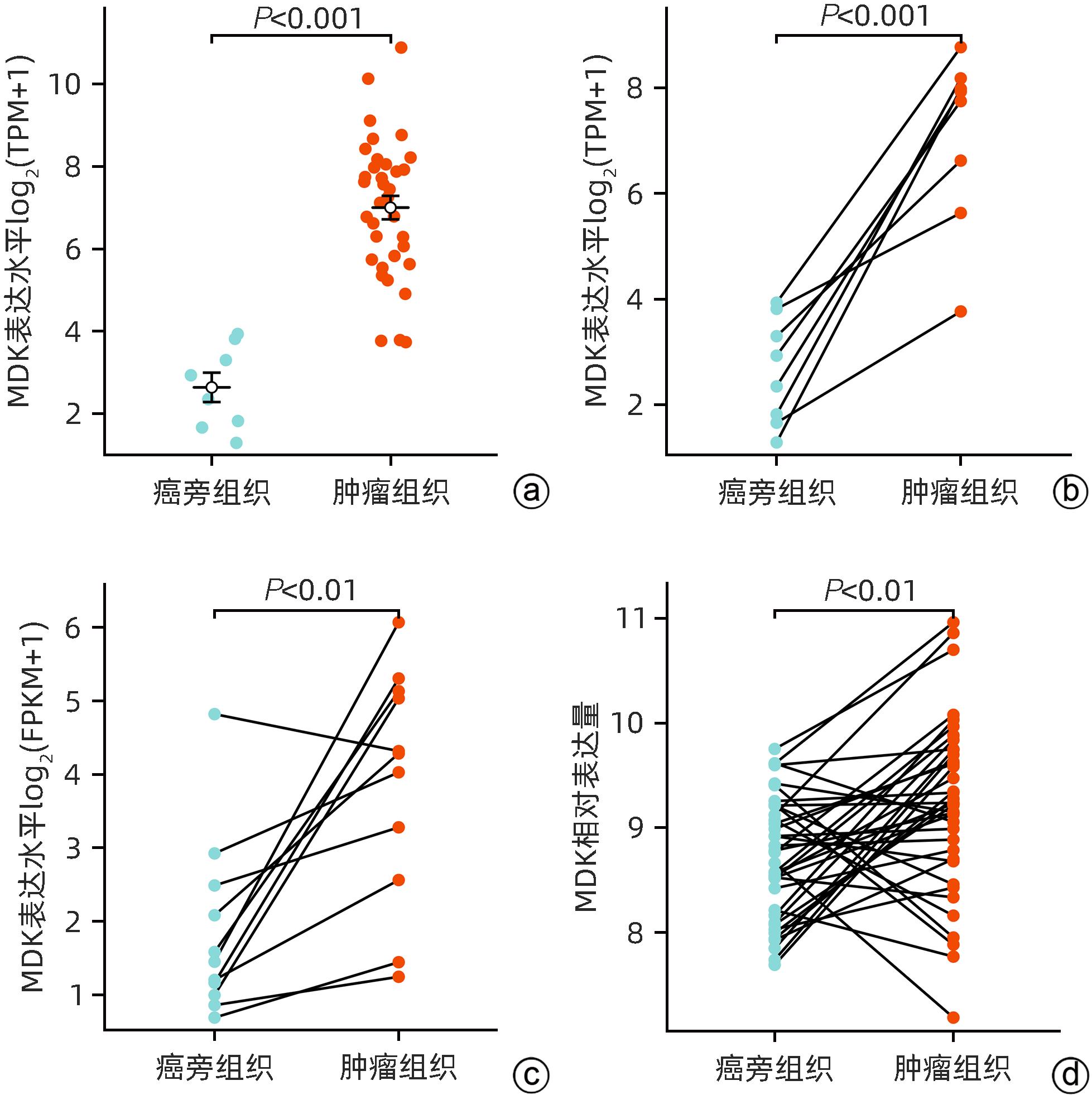
 下载:
下载:
